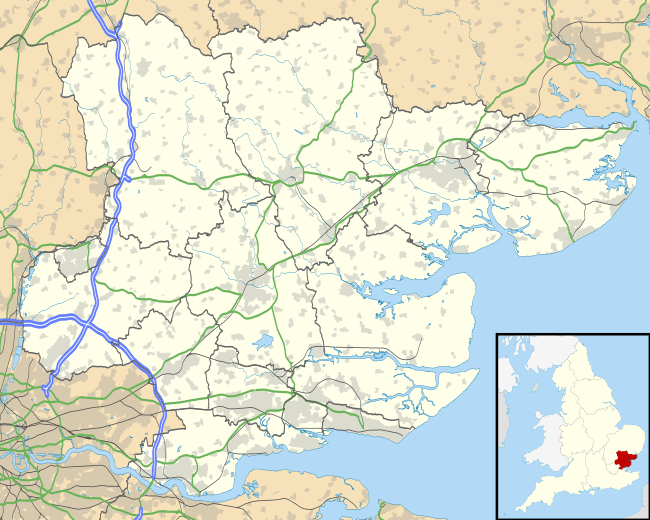Buckhurst Hill tube station
| Buckhurst Hill | |
|---|---|
|
Station entrance | |
 Buckhurst Hill Location of Buckhurst Hill in Essex | |
| Location | Buckhurst Hill |
| Local authority | District of Epping Forest |
| Number of platforms | 2 |
| Fare zone | 5 |
| London Underground annual entry and exit | |
| 2012 |
|
| 2013 |
|
| 2014 |
|
| 2015 |
|
| Key dates | |
| 22 August 1856 | Opened |
| 1892 | resited |
| 6 January 1966 | Goods yard closed[2] |
| Other information | |
| Lists of stations | |
| WGS84 | 51°37′36″N 0°02′49″E / 51.62666°N 0.04694°ECoordinates: 51°37′36″N 0°02′49″E / 51.62666°N 0.04694°E |
|
| |
Buckhurst Hill is a London Underground station, in the Epping Forest district of Essex. It is served by the Central line and is between Woodford and Loughton. It is the larger of the two Underground stations in the town of Buckhurst Hill, with Roding Valley station being the smaller.
History

The station opened on 22 August 1856 as part of the Eastern Counties Railway branch from London to Loughton. It originally had staggered platforms, with the main buildings on the down side (tracks heading away from London). The 1856 station house survives to the south of the present platforms, but most of the present station dates from 1892, when the entrance was moved to Victoria Road. The building is similar to that at Billericay. Both were designed by W. N. Ashbee, the chief architect of the Great Eastern Railway,[3] of which the station was a part, which was, from 1923, to become part of the London & North Eastern Railway.
The station was transferred to London Underground ownership as part of the New Works Programme, 1935-1940 scheme that saw the electrification of the branch to form part of the Central line. This occurred on 21 November 1948. The station maintains its late Victorian ambiance to a surprising extent. There are disused exit/entrances to the south of the station that date from the transfer to the Underground; these gave direct access to Lower Queens Road and Queens Road. The pedestrian underpass between these two roads is still open. These exits were closed permanently in the 1980s, saving the expense of installing automatic ticket barriers on these additional two entries.
For the purposes of fare charging it is in Zone 5. As of 2007 it is the only station on the eastern portion of the Central line in that zone, in fact Buckhurst Hill is the only through station in zones 1 to 6 on the London Underground to be in a zone on its own, passengers travelling from the station leaving in either direction must cross a zone boundary.
Gallery
- The station as today
- Looking north
- Looking south
- Looking south from the footbridge
- Looking north from the footbridge
 Roundel
Roundel
References
- 1 2 3 4 "Multi-year station entry-and-exit figures" (XLS). London Underground station passenger usage data. Transport for London. April 2016. Retrieved 3 May 2016.
- ↑ Hardy, Brian, ed. (March 2011). "How it used to be - freight on The Underground 50 years ago". Underground News. London Underground Railway Society (591): 175–183. ISSN 0306-8617.
- ↑ Kay, Peter (2006). Essex Railway Heritage. Wivenhoe UK: Peter Kay. pp. 28–29. ISBN 978 1 899890 40 8.
External links
| Wikimedia Commons has media related to Buckhurst Hill tube station. |
- http://citytransport.info/BuckhurstHill.htm - Photographs of the Victorian era station platforms, shelters and waiting rooms.
| Preceding station | Following station | |||
|---|---|---|---|---|
| Central line Epping Branch | towards Epping |